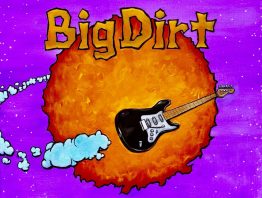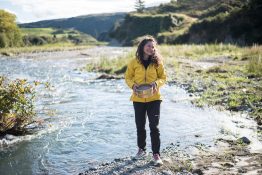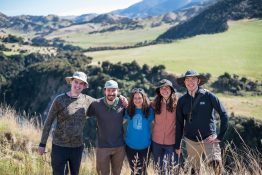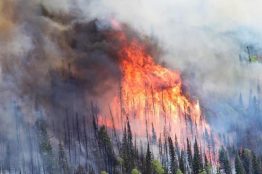David Montgomery is a geomorphologist who looks at the processes shaping Earth’s surface and how they affect ecological systems — and human societies. He has studied everything from the ways that landslides and glaciers influence the height of mountain ranges to the way that soils have shaped human civilizations, both now and in the past. He has worked in mountain ranges throughout the world, from the Cascades in the Pacific Northwest to the Andes in South America and Tibet, and the Himalaya in Central Asia.
Read more »S2 E1: Alison Duvall and Tectonic Geomorphology
Season 2 of FieldSound, the official UW College of the Environment podcast, launches today with this episode! Be sure to like, share and subscribe to catch a new episode each Tuesday. In this episode, Associate Professor of Earth and Space Sciences Alison Duvall shares about tectonic geomorphology, her work with the Cascadia CoPes Hub to increase knowledge about natural hazards and empower communities to build resilience in the face of environmental change, and her path to becoming a scientist.
Read more »UW geologist connects landslide research with communities in high-risk regions
Alison Duvall, University of Washington associate professor of Earth and Space Sciences, is working to understand how climate and climate change might affect the frequency, severity and downstream impacts of landslides, and bring what she learns to community partners working to reduce risk in vulnerable places.
Read more »Q&A: How ‘slow slip’ earthquakes may be driven by deep hydraulic fracturing
The Cascadia Subduction Zone is a massive geologic fault that last ruptured in January 1700. But while this fault has stayed quiet for centuries, it regularly generates small tremors that accompany gradual, nondisruptive movement along the fault. The tiny tremor events and slow slippage are known collectively as “episodic tremor and slip.” Seismic waves associated with these tremor events are recorded and tracked by the UW’s Pacific Northwest Seismic Network.
Read more at UW News »UW research helps California forest managers assess smoke hazards from prescribed burns
Across the American West, managers of fire-prone landscapes are increasingly setting small fires to prevent larger, more destructive ones. Commonly called prescribed burns, these targeted, controlled fires keep forests healthy by reducing the buildup of grasses, leaves, branches and other debris that can fuel larger wildfires and smoke out nearby communities. But smoke from prescribed burns also presents health risks. Today’s forest managers must ask themselves — how much prescribed burning is too much?
Read more at UW News »





